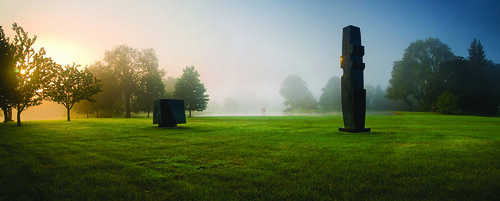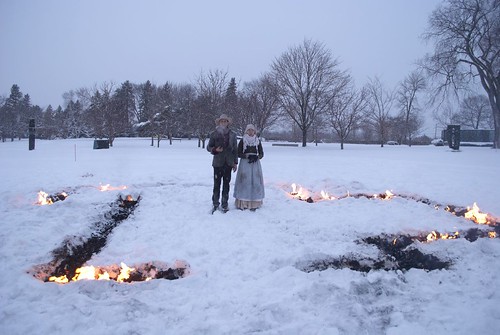2013 UWM Art Education Institute - Attentive living: Art, Nature and Place
 Fee (noncredit): $170 until 1 June 2013; $200 thereafter. Advanced registration required. Register online now.
Fee (noncredit): $170 until 1 June 2013; $200 thereafter. Advanced registration required. Register online now.
Participants have the option of enrolling for 1 credit as either an undergraduate or graduate student through the University of Wisconsin-Milwaukee. For those looking for a more extended studio experience and additional credits, the UWM Peck School of the Arts will offer two complementary one‐credit intensive workshops on the UWM campus in the afternoon and evening of the same week—Print and Narrative Forms: Exploring Process, Collaboration and Ecology; and Natural Impressions: Jewelry from Natural Forms. For more information on registering for credit or on the complementary courses, contact Prof. Laura Trafi-Prats at trafipra@uwm.edu.
The UWM Art Education Institute at the Lynden Sculpture Garden welcomes K-12 teachers, community and museum educators, and docents with an interest in developing an interdisciplinary and integrated curriculum that explores the relationship between art, nature and place. Generalist teachers and those with expertise in science, language and social studies, as well as the arts, are encouraged to participate.
While contemporary visual culture often depicts nature and culture as objects of consumption, existing educational research demonstrates that by grounding learning in local phenomena and place we create new ways of thinking, knowing and representing. As Maxine Greene suggests in Landscapes of Learning, aesthetic experience is an essential process for questioning, analyzing and making sense of the places, environments and communities that make us who we are. In addition to many practical issues based on economy and sociality, a personal sense of emplacement and geography also includes mythic, aesthetic, and transcendent narratives. The history of art is filled with images of extraordinary places that provide a lasting experience and a sense of reverence, comfort, and transcendence that force us to give up the mundane and taken-for-granted and launch new and open-ended explorations.
The Lynden Sculpture Garden may be considered one such extraordinary place. Situated in the old farmland of the currently suburbanized River Hills, its spaces hold the aesthetic potential to nurture personal, community and environmental questioning and reflection. Through a series of hands-on experiences and artistic dialogs with curators, artists, naturalists and educators, participants in this workshop will engage in the creation of what Olivia Gude, in Principles of Possibility; Considerations for a 21st century Art and Culture Curriculum, describes as an art curriculum centered on principles of attentive living based on an in-depth and sustained exploration of place through local research, spatial interactions, site-specific activities, and exploration of subjective implications and personal experience.
Curriculum
June 24 – Exploring our personal relations with place - 9 am-12:30 pm
In this session we will learn to analyze and represent our connections to place, your work, home, community as well as the Lynden Community Garden. What are your places of refuge? What are the places where you can slow-down, contemplate, feel grounded or even feel extraordinary sensations? What are the places where you can give up routine and build personal and genuine connections? In this session we will:
• Look and talk on how some historical and contemporary artists have used land and landscape to personally respond to the aforementioned questions.
• Stroll the grounds of the Garden with director and curator Polly Morris, to learn the history and imaginaries of how Harry Lynde Bradley and Margaret (Peg) Bradley envisioned and constructed such extraordinary and mythic space.
• Through sketching and writing, explore personal emplacement in Lynden Sculpture Garden. Compare/contrasts with other personal geographies of our everyday lives.
• Construct an instant book presenting such visual narratives.
June 25-26 - Art-based interpretations of land and nature - 9 am-12:30 pm
We will start this session by sharing and discussing our narratives and books. We will continue exploring the notions of emplacement through a collaboration with artist Roy Staab. We will learn about his combined art-based processes of investigating the environment that include performance, community interaction, collection of materials, construction and documentation. In these sessions we will:
• Look and talk about the work of Roy Staab
• Work with the artist in a site-specific intervention in the Garden
• Discuss on how art principles and processes can help us to reflect and work with nature in an aesthetical, processual, contemplative and non-exploitative way.
June 27-28 - Exploring the connections between art and nature through integrative strategies derived from contemporary art - 9 am-12:30 pm
We will explore different principles of integration by looking and talking about the work of Lynden artists-in-residence Shana McCaw and Brent Budsberg, and Emilie Clark. We will discuss how these artists use methodologies derived from science, ecology, or history to produce art and knowledge that study and actualize Lynden’s histories, sites, and environments
• Look and talk about the work of aforementioned artists and other and discuss how their research strategies can inform an integrative curriculum for K-12 that explores the relations of art and nature.
• Stroll the grounds of the Garden with a gardener/naturalist/arborist to gain scientific, and environmental knowledge of the place.
• Devise through planning, sketches, notes a project in collaboration with your students where you would use such scientific knowledge and methodologies to create integrated curriculum centered on contemporary art and ideas.
June 29- Exhibition of participants’ work - 12 noon-5 pm
Participants will have the opportunity to present the productions derived from the different sessions. They will install their work in one of the rooms of Lynden’s Sculpture Garden’s house. There will be a public opening and short gallery talk to engage community and visitors.
Core Readings
Gradle, Sally, (2008). When Vines Can Talk: Community, Art and Ecology. Art Education (61) 6, pp. 6-1
Graham, Mark A. (2007). Exploring Special Places: Connecting Secondary Art Students to Their Island Community. Art Education (60) 3, pp. 12-18.
Gude, O. (2007). Principles of Possibility. Considerations for a 21st century Art and Culture Curriculum. Art Education (60) 1, pp. 6-17.
Marshall, Julia (2010). Five Ways to Integrate: Using Strategies from Contemporary Art. Art Education (63) I3, pp. 13-19.
Powell, Kimberly, (2010). Viewing Places: Students as Visual Ethnographers. Art Education (63) 6, pp. 45-53.



